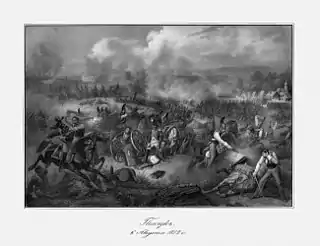| First Battle of Polotsk | |||||||
|---|---|---|---|---|---|---|---|
| Part of the French invasion of Russia | |||||||
.jpg.webp) Belarusian Polatsak (Połacak) | |||||||
| |||||||
| Belligerents | |||||||
|
|
| ||||||
| Commanders and leaders | |||||||
|
|
| ||||||
| Strength | |||||||
|
18,000–44,000 men[1][2][3] 150 guns[4][1] |
17,000–20,000 men[1][2][3] 98 guns[4][1] | ||||||
| Casualties and losses | |||||||
| 2,500–6,000[4][1][3] |
1,800–5,500 killed and wounded[1][4][3] 1,200–1,500 captured[4][3] 14 guns[4][3] | ||||||

In the First Battle of Polotsk, which took place on 17–18 August 1812, Russian troops under the command of Peter Wittgenstein fought French and Bavarian troops led by Nicolas Oudinot near the city of Polotsk, halting Oudinot's advance toward Saint Petersburg.[5] The First Battle of Polotsk should be distinguished from the Second Battle of Polotsk which took place during the same campaign two months later.[6]
Prelude
After the battle of Klyastitsy and several minor losses, Oudinot's Corps retreated to Polotsk.[7]
Battle
In the early morning of 17 August, the 1st Infantry Corps led by Wittgenstein attacked the French positions near the village of Spas, forcing the French to retreat. Oudinot transported additional units to the sector of the attack and also counterattacked in the centre. By the night both the French and the Russians managed to keep their positions. Oudinot was wounded and had to hand over the command to Gouvion Saint-Cyr.[7]
The next morning Gouvion Saint-Cyr undertook a major offensive. He managed to mislead Wittgenstein about the area of the offensive, regroup his troops and suddenly attack the left flank and centre of the Russian positions. In the beginning the offensive was a major success, the French troops crushed the Russians and captured seven cannons.[7]
When defeat seemed imminent, Wittgenstein organized a cavalry counterattack. It caused a scare among the French, who ceased the offensive and retreated. Wittgenstein retreated to the Drissa. Wittgenstein managed with his much smaller force effectively halted two French corps trying to advance to Saint Petersburg, which deed later gave him the Russian general-in-chief post.[7]
Casualties
French-Bavarian losses numbered 6,000 killed, wounded. The Russians lost 5,500. Bavarian general officer losses were heavy. General of Infantry Bernhard Erasmus von Deroy was mortally wounded and General-Major Siebein was killed. General-Majors Vincenti and Raglovitch were both wounded. Among the French, both Oudinot and General of Brigade François Valentin were wounded. Russian Generals Berg, Hamen, and Kazatchkowski suffered wounds.[8][7]
Aftermath
For the next two months both the French and the Russians did not attempt to upset the balance of powers.[8][7]
See also
Notes
- 1 2 3 4 5 6 7 Bodart 1908, p. 435.
- 1 2 Nafziger 1988, p. 146.
- 1 2 3 4 5 6 Clodfelter 2008, p. 162.
- 1 2 3 4 5 6 Nafziger 1988, p. 157.
- ↑ napoleon.org 2021.
- ↑ Seton-Watson 1967.
- 1 2 3 4 5 6 Riehn 1990, pp. 277–278.
- 1 2 Smith 1998, pp. 386–387.
References
- Bodart, Gaston (1908). Militär-historisches Kriegs-Lexikon (1618-1905). Retrieved 7 April 2021.
- Clodfelter, Micheal (2008). Warfare and armed conflicts : a statistical encyclopedia of casualty and other figures, 1494-2007. ISBN 9780786433193. Retrieved 7 April 2021.
- Nafziger, George (1988). Napoleon's Invasion of Russia. Presidio Press. ISBN 0-89141-322-7.
- napoleon.org (2021). "Wittgenstein, Peter Khristianovich". Retrieved 7 April 2021.
- Riehn, Richard K. (1990). 1812 : Napoleon's Russian campaign. ISBN 9780070527317. Retrieved 7 April 2021.
- Seton-Watson, Hugh (1967). The Russian empire, 1801-1917. Retrieved 8 April 2021.
- Smith, Digby (1998). The Napoleonic Wars Data Book. London: Greenhill. ISBN 1-85367-276-9.
See also
External links
 Media related to Battle of Polack (1812, August) at Wikimedia Commons
Media related to Battle of Polack (1812, August) at Wikimedia Commons
| Preceded by Battle of Smolensk (1812) |
Napoleonic Wars First Battle of Polotsk |
Succeeded by Battle of Valutino |